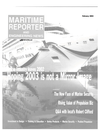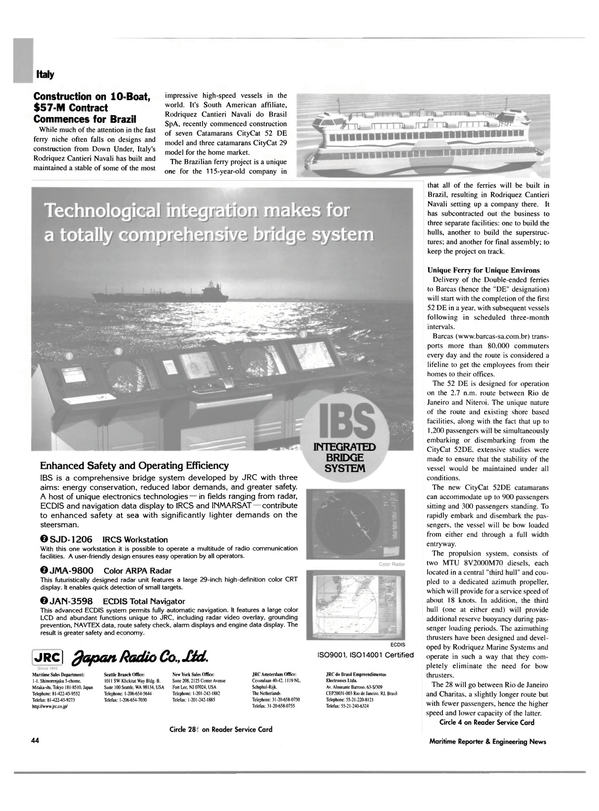
Construction on 10-Boat, $57-M Contract Commences for Brazil
While much of the attention in the fast ferry niche often falls on designs and construction from Down Under, Italy's Rodriquez Cantieri Navali has built and maintained a stable of some of the most impressive high-speed vessels in the world. It's South American affiliate, Rodriquez Cantieri Navali do Brasil SpA, recently commenced construction of seven Catamarans CityCat 52 DE model and three catamarans CityCat 29 model for the home market.
The Brazilian ferry project is a unique one for the 115-year-old company in that all of the ferries will be built in Brazil, resulting in Rodriquez Cantieri Navali setting up a company there. It has subcontracted out the business to three separate facilities: one to build the hulls, another to build the superstructures; and another for final assembly; to keep the project on track.
Unique Ferry for Unique Environs Delivery of the Double-ended ferries to Barcas (hence the "DE" designation) will start with the completion of the first 52 DE in a year, with subsequent vessels following in scheduled three-month intervals.
Barcas (www.barcas-sa.com.br) transports more than 80.000 commuters every day and the route is considered a lifeline to get the employees from their homes to their offices.
The 52 DE is designed for operation on the 2.7 n.m. route between Rio de Janeiro and Niteroi. The unique nature of the route and existing shore based facilities, along with the fact that up to 1,200 passengers will be simultaneously embarking or disembarking from the CityCat 52DE. extensive studies were made to ensure that the stability of the vessel would be maintained under all conditions.
The new CityCat 52DE catamarans can accommodate up to 900 passengers sitting and 300 passengers standing. To rapidly embark and disembark the passengers, the vessel will be bow loaded from either end through a full width entryway.
The propulsion system, consists of two MTU 8V2000M70 diesels, each located in a central "third hull" and coupled to a dedicated azimuth propeller, which will provide for a service speed of about 18 knots. In addition, the third hull (one at either end) will provide additional reserve buoyancy during passenger loading periods. The azimuthing thrusters have been designed and developed by Rodriquez Marine Systems and operate in such a way that they completely eliminate the need for bow thrusters.
The 28 will go between Rio de Janeiro and Charitas, a slightly longer route but with fewer passengers, hence the higher speed and lower capacity of the latter.
Circle 4 on Reader Service Card
Read Construction on 10-Boat, $57-M Contract Commences for Brazil in Pdf, Flash or Html5 edition of February 2003 Maritime Reporter
Other stories from February 2003 issue
Content
- The USCG, MTSA '02 and IMO - The New Faces of Security page: 8
- Littoral Combat Ship Takes One Step Closer to Reality page: 10
- Secure Marine Transportation... Priceless? page: 12
- Three PacifiCat-class Fast Ferries to be Sold page: 18
- The Rising Value of Propulsion Business page: 19
- Navigator of the Seas—A New Course for Profitability page: 24
- Plug and Play page: 28
- Cruise Ship Design Trends Mirror Marine Marketplace page: 31
- Deltamarin Expands to China to Thwart Cruise Downturn page: 34
- Gotar: Keeping Ships Clean From the Inside page: 35
- Coral Princess Debuts With Unique Propulsion System page: 35
- Sick Ships, Project America and a Merger page: 36
- A 360 O page: 38
- Swimmin' With the Fishes STN Atlas, WirtsilS Propulsion "Dolphin" Pod Proves Popular page: 38
- M/S Zuiderdam: Modern With Elegant Taste page: 40
- Construction on 10-Boat, $57-M Contract Commences for Brazil page: 44
- INCAT — A Delicate Balance for the Future page: 46
- NCL Debuts Newest Star with NYC Flair page: 48
- Damen Delivers High Level of Tug Tech page: 49
- A Proven, New Approach for Vessel Insulation page: 50
- The Dilemma: Competent Crews vs. Costs page: 54
- Blue Ridge Officers Complete Safety Training page: 57
- Shipping 2003: Don't Stop Thinking About Tomorrow page: 58
- Cruise Industry Gathers in Miami page: 61


